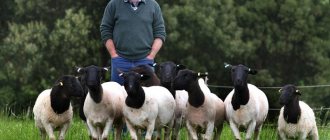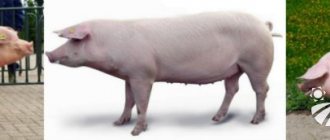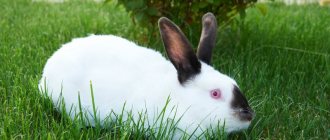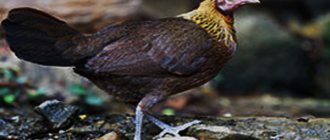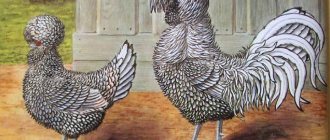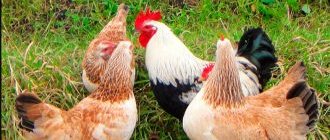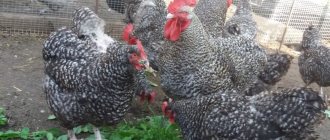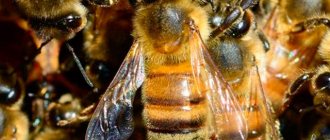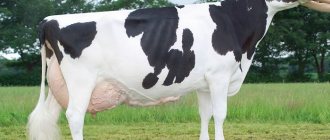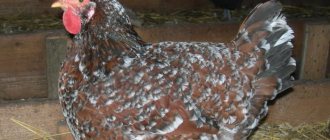Moscow black chickens are a relatively young breed, but still popular. The poultry belongs to the meat and egg category and shows good productivity results. The breed is unpretentious and has an attractive appearance. Chickens are raised on private farms and poultry farms. Their productivity directly depends on the correctness of the content.
A breed with good vitality, disease resistance and temperament
The Moscow fighting chicken has nothing to do with the black one. It was developed back in the 18th century and was used for cockfighting. The fighting breed of chickens is not common and, unlike the Moscow black, is expensive. Externally, the fighting bird is noticeably different from the black laying hen, and even a beginner cannot confuse them.
How the breed was obtained
Specialists from the Moscow Agricultural Academy and the Brattseva Poultry Farm worked on developing the breed. They were guided by the desire to obtain universal meat-egg birds that would normally adapt to harsh climate conditions.
Representatives of the following breeds were used for selection:
- New Hampshire.
- Yurlovskaya vociferous.
- Italian partridge.
From New Hampshire hens, Moscow individuals received large body sizes and high-quality meat, and from Italian laying hens - good egg production. Yurlov's vocal chickens influenced adaptability.
Content Features
From their own experience, farmers saw that no other breed is so well adapted to the harsh Russian climate.
Attention! They are not afraid of even frosts above -30°C. The only thing that can happen is frostbite on the combs, but that only happens to roosters.
If the temperature in the room where the birds are located is exactly 0°C, then the chickens will not stop laying eggs in winter. During this period, good nutrition is important, and instead of water, snow will come off, which the chickens will happily peck.
You can keep this breed in any place convenient for you. They feel calm both in cages and in a common chicken coop. They quickly get used to the area and their owner, so you can safely let them out into the yard. The birds are very calm and peaceful, they get so used to people that they can even walk into people’s hands. But chickens, on the contrary, are very active and elusive. They should be released for walking together with the club. She will be able to protect her offspring from danger.
Many people believe that when buying chickens, you need to choose the largest ones. In this case, this is an error.
Advice! Medium-sized chickens are considered the most productive. They will not rapidly gain weight, so egg production will not suffer.
Appearance of black Moscow
The description of the appearance of the Moscow breed mentions a massive body and contrasting color. Moreover, such characteristics are characteristic of both males and females. The black plumage with a glossy sheen is dense and dense, so birds can easily withstand harsh climatic conditions.
How to tell the sex of a chicken
It is almost impossible to determine the sex of a chicken under 1.5 months old. The birds are almost completely black. The first sexual signs appear 6-7 weeks after birth. During adolescence, it can be determined that the limbs of females are darker than those of males.
Exterior and acceptable color
Chickens of the Moscow Black breed have several distinctive features in the exterior:
- A rooster weighs 3.5 kg, and a chicken weighs 2.5 kg.
- On the large head there is a sharp-toothed comb in the shape of a leaf with a red color.
- The neck has a slight bend.
- The eyes have a brown or orange iris.
- The short beak is black.
- The earlobes are white or red in color.
- The massive body is slightly pushed forward.
- The back is wide, with a straight fit.
- The paws have no feathers, but are quite powerful.
- The wings are well developed and pressed to the body.
- The tail is of medium length and low set.
Moscow chickens have an elongated shape and massive muscles. They have dense feather cover with gold or copper colored markings. The largest number of inclusions is present on the mane, lower back and shoulders.
There are 2 types of colors:
- Golden yellow.
- Copper red.
Possible flaws
Birds with yellow beaks and limbs are culled. A slight greenish tint is not a reason for rejection. The feather cover may contain several white wings, but as they grow older they disappear.
Black Moscow chicken breed.
Molting and break in egg production
Moulting for “Moscow” chickens begins in the fall, like any other breed. The process of changing feather cover occurs from one to three months. Before winter, the plumage completely changes to a new one. During the molting period, chickens become a little lethargic, and egg production may decrease. To replenish strength and help shed faster, you need to increase nutritional supplements in the food, give more green grass, beets, zucchini or pumpkin.
A break in egg production in laying hens can occur:
- when she needs to replenish the supply of rudiments, this happens from 2 to 10 days;
- in winter, when the air temperature is below zero;
- during the molting period, when all energy is spent on the formation of new plumage.
Characteristics of black Moscow chicken
The breed has become widespread due to its high egg production and tasty meat. In addition, representatives of the breed are not afraid of severe frosts.
Bird temperament
According to poultry farmers, Moscow laying hens have a calm and balanced disposition. At the same time, their genes contain data from Yurlovsky vocal animals, which are of a fighting nature.
If males face a threat, they will suddenly attack the source of danger, protecting the young and females. In all other cases, birds do not show aggression.
Laying hens are quite noisy, so they cackle loudly most of the day. For the normal development of the livestock, it is necessary to provide a walking yard. When they stay in a closed environment for a long time, they become nervous and stop laying eggs normally.
Chickens should roam outdoors.
Productivity table
Productivity indicators are determined by the environment in which the birds live. With a shortage of lighting and food, the number of eggs is reduced, and with an excess of food, animals begin to quickly gain excess weight, which impairs egg production.
| Number of eggs per year | 210-250 pieces per year |
| Egg weight | 50-60 g |
| Rooster and chicken weight | 3.5 kg and 2.5 kg respectively |
Hatching instinct
Moscow chickens do not have a pronounced brooding instinct. Finding a good hen among all the livestock is quite difficult. Females refuse to sit in one place for a long time, so to obtain a brood, they use an incubator or a hen of another breed, placing eggs under it for incubation.
Reviews from gardeners
Breeders of the Moscow breed leave only positive reviews about it.
- General use chickens, as they are also commonly called among breeders, are universal - they produce tasty meat and are distinguished by good egg production.
- For many, especially novice poultry farmers, this is an excellent option - chickens are not demanding in care and nutrition, while their productivity remains at the highest level.
- Many are pleased that the bird is calm and does not require a special enclosure for walking, which makes caring for it much easier.
- Others prefer this breed due to its good, almost 100%, fertilization and survival rate of chicks.
How to keep
There are no particular difficulties in caring for Moscow birds. The main thing is to provide them with comfortable living conditions and adhere to the correct feeding regimen.
Walking yard
Representatives of the breed need frequent and long walks in the open air. To make them feel comfortable, it is necessary to arrange a spacious walking yard.
It can be combined with a poultry house using a manhole. To protect animals from atmospheric influences, it is necessary to provide a canopy. The walking area should be sowed with vegetation so that the birds will peck at it.
In the summer, chickens spend most of their time outdoors. They go outside immediately after morning feeding, and return to the house only after sunset.
In winter, the duration of activity is reduced to 1-1.5 hours. Thick feather cover protects birds from freezing, but their limbs and combs are vulnerable. Prolonged stay in open space is accompanied by frostbite.
Walking for chickens.
Setting up a chicken coop
When building a chicken coop, you need to provide a floor covering. For these purposes, straw, dry leaves, sunflower husks or peat are used. Such a layer will warm the birds, absorbing all excess moisture.
The amount of litter is selected based on the number of chickens in the house. For 1 individual per year you need about 15 kg of dry flooring. An infrared light lamp should be installed above the perch.
Food is stored in simple containers. In early spring, it is recommended to update the litter. Wall surfaces should be treated with lime mortar to kill germs.
In winter, it is worth periodically adding new sawdust 15 cm thick. Otherwise, the litter will begin to collapse, and the birds will be susceptible to diseases due to hypothermia.
In summer, the litter is updated only periodically. In winter, animals need artificial lighting.
In the chicken coop it is necessary to lay bedding on the floor.
Drinkers and feeder
Mandatory accessories for a chicken coop are feeders and drinkers. They are necessary so that birds can take food and water on time without feeling a shortage of any product.
When choosing a feeder, you should give preference to elongated structures made of metal or wood. The products are placed on an elevated surface so that birds can get food without raking it on the ground.
The drinking bowl should be clean and inaccessible to birds' feet. If they start to climb into it, instead of water, a solid swamp will appear. The optimal container volume is 5 liters. It is not recommended to use larger containers, since exposure to high temperatures may cause the liquid to deteriorate.
Drinking bowl in the chicken coop.
Feeding adults
Since Moscow chickens are representatives of the meat and egg breed, they should receive more food than individuals of one direction. Despite the unpretentiousness of animals to feed, to increase productivity it is necessary to create a balanced diet.
The main ingredient for feeding is feed with hay flour. In summer, it can be replaced with succulent food (vegetables, fruits and herbs).
Wet mash is best prepared from wheat, corn, barley and other grains. Then they add fruits and vegetables, whole grains. To avoid obesity in animals, you need to include bran in your diet. They will reduce the calorie content of the feed.
Herbs and vegetables are added to the mash.
Diet and feeding scheme for chickens
Chickens up to 2 weeks of age should be given specialized chick food or crushed boiled eggs. After 14 days, it is necessary to begin accustoming animals to roughage feed. To do this, you can include vegetables, cottage cheese and fresh herbs in your diet.
Chickens are accustomed to roughage after 14 days.
Planned herd replacement
Upon reaching 8 months of age, Moscow chickens become sexually mature. Their eggs can already be used for incubation. Since laying hens do not have a pronounced maternal instinct, the stock needs to be renewed every 3-4 years. Otherwise, productivity will decrease.
Care during shedding period
The planned change of plumage occurs in the autumn and takes up to 2 months. At this time, birds become vulnerable to infections and fungal diseases.
Their immune system is weakened due to the need to form new feathers. During seasonal molting, egg production deteriorates, but then resumes.
During the period of feather renewal, birds need to be protected from dampness, cold and draft. In addition, you should monitor the cleanliness of the chicken coop and give the individuals as many vitamins as possible. The diet should include fresh vegetables, shells, bone meal and chalk.
Features of feeding
Feeding is very important for high productivity. Proper and varied nutrition will only have a positive effect on the chickens’ body. Since this breed includes characteristics of both egg and meat groups, it accordingly needs less food than meat animals and more than egg animals. Egg production and the rate of muscle growth depend on the amount of feed.
By the appearance of the eggs, you can determine what the chickens’ body lacks.
Advice! A very thin shell indicates a lack of vitamins A and D. If there are stains on the eggs that resemble marble, this means that there are few minerals in the diet.
Typically, chickens are fed with various grain crops, mixed feed, hay flour, and boiled potatoes. But, in addition to this, you should add fresh greens (cut grass), vegetables and fruits to your diet. Also remember that eating boiled potatoes too often can lead to obesity. It is recommended that if it is not possible to let chickens out to pasture, at least sometimes add dried larvae or meat to the food. Thanks to this, the birds will receive the necessary protein.
Don't neglect drinking. Chickens must always have water. It will be useful to give chickens small limestones; they have a good effect on the stomach and help them digest food better.
Disease susceptibility
Chickens of the Moscow breed get sick only occasionally. They are practically not afraid of dangerous diseases that can destroy livestock.
But in order to prevent seasonal diseases it is necessary:
- Include vitamin complexes in your diet.
- Carry out routine cleaning of the chicken coop 2 times a year to remove harmful microorganisms.
The presence of diseases can be determined by the following signs:
- The birds became lethargic and inactive.
- The birds act worried and excited.
- Breathing becomes difficult.
Vaccinations must be done according to a specific schedule.
Possible diseases
Characteristics of the breed include high resistance to many diseases. If the conditions of care are violated - keeping them in a dirty, cold chicken coop - the birds develop colds. To avoid this, it is necessary to optimize care according to the requirements described above.
The young litter exhibits various pathologies - curvature of the comb, paws, and neck. The reasons are the use of expired, irregularly shaped and sized eggs for breeding offspring, as well as non-compliance with the temperature regime in the incubator.
To prevent other infections, breeders vaccinate chicks at an early age, which helps increase the chances of survival.
If infected with diseases, vaccinated chickens easily tolerate them and quickly recover. Also, for preventive purposes, it is necessary to keep the chicken coop clean, ventilate it regularly, remove leftover feed in a timely manner and change the water in the drinking bowls.
Breeding black Moscow chicken
The key method for breeding Moscow chickens is incubation. Birds refuse to hatch eggs, so you need to select fresh samples and place them in an incubator.
First of all, it is worth enlightening the eggs of devices called an ovoscope. It allows you to check the condition of the embryo. The presence of inclusions in the protein is not allowed. The yolk should be in the center of the egg. The presence of cracks in the shell is a sign for the rejection of eggs.
After birth, the chicks remain weak. Therefore, their storage place must be equipped with lighting and heating devices. Due to vitamin deficiency, it is better to feed chickens green onions.
Raising chickens
Young animals are raised in the same way as other breeds. In the first 45 days, chickens need to be provided with heating and lighting 22 hours a day. Chopped green onions should be given to chicks from the 3rd day, otherwise they will have an acute deficiency of vitamins.
Young animals should always have water and crushed grain. From 14 days, in warm and dry weather, the chickens are taken out for a walk for 20–30 minutes in a well-fenced enclosure with grass.
Breeds with similar characteristics
The list of breeds with similar properties includes:
- Kuchinskaya. The birds were bred in the Moscow region. They quickly adapt to the climatic conditions of mid-latitudes, are resilient and weigh 3-4 kg. Egg production reaches 230-240 eggs per year.
- Zagorsk salmon. Breeders from Sergiev Posad worked on breeding the breed. Animals quickly gain weight, begin to lay eggs quickly and produce up to 180-200 eggs per year. They have a pronounced brooding instinct.
- May Day. The breed originated in Ukraine, but is popular in Russia. The advantages of the breed include resistance to adverse weather and egg production of 200 eggs per year. Young individuals are hardy and easy to care for.
Pervomayskaya breed of chickens.
